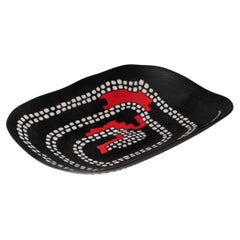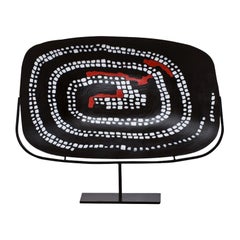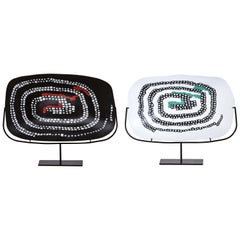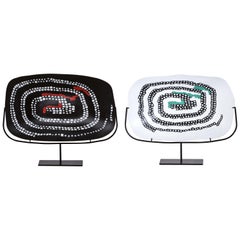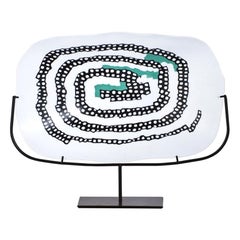Serpente Carlo Scarpa
Vintage 1940s Vases
Murano Glass
21st Century and Contemporary Italian Decorative Dishes and Vide-Poche
Glass
21st Century and Contemporary Italian Modern Decorative Dishes and Vide-...
Blown Glass
21st Century and Contemporary Italian Modern Decorative Dishes and Vide-...
Blown Glass
21st Century and Contemporary Italian Decorative Dishes and Vide-Poche
Glass
People Also Browsed
2010s British Scandinavian Modern Tables
Mohair, Oak
Early 20th Century Italian Art Deco Vases
Glass, Art Glass, Blown Glass, Murano Glass
Vintage 1950s Italian Mid-Century Modern Cabinets
Brass
21st Century and Contemporary Italian Modern Screens and Room Dividers
Paper
Vintage 1970s Italian Mid-Century Modern Dining Room Chairs
Leather, Walnut
Vintage 1950s Italian Mid-Century Modern Figurative Sculptures
Art Glass, Blown Glass, Murano Glass, Glass
Mid-20th Century Italian Mid-Century Modern Glass
Murano Glass, Sommerso
Vintage 1970s Italian Mid-Century Modern Vases
Murano Glass
2010s Neo-Expressionist Animal Paintings
Canvas, Glass, Resin, Oil, Acrylic
Vintage 1970s Italian Mid-Century Modern Loveseats
Bouclé, Foam, Wood
2010s Neo-Expressionist Animal Paintings
Canvas, Oil
Vintage 1940s Italian Vases
Murano Glass
20th Century Italian Mid-Century Modern Decorative Bowls
Glass, Art Glass, Blown Glass, Murano Glass, Sommerso
20th Century French Art Nouveau Table Lamps
Glass
Vintage 1970s Italian Hollywood Regency Ashtrays
Crystal
Vintage 1930s Italian Other Glass
Murano Glass
Carlo Scarpa for sale on 1stDibs
Carlo Scarpa was born in Venice in 1906 and became one of the leading figures of architecture and international design during the 20th century. At merely 21 years old — and still a student at the Academy of Fine Arts — Scarpa began working as a designer for master Murano glassmaker M.V.M. Cappellin. Within a few years, he completely revolutionized the approach to art glass.
In a short time, under the guidance of Scarpa, the Capellin furnace not only established itself as the top glass company, but above all it introduced modernity and international fame to Murano glassmaking. Scarpa created a personal style of glassmaking, a new vision that irreversibly changed glass production.
The young Scarpa experimented with new models and colors: his chromatic combinations, impeccable execution and geometric shapes became his modus operandi. Thanks to Scarpa’s continuous research on vitreous matter, Cappellin produced a series of high-quality glass objects, that saw the company revisiting ancient processing techniques such as the watermark and Phoenician decoration.
When he encountered the challenge of opaque glass, Scarpa proposed introducing textures of considerable chromatic impact, such as glass pastes and glazed glass with bright colors. Scarpa also collaborated in the renovation of Palazzo da Mula in Murano, the home of Cappellin. At the academy, he obtained the diploma of professor of architectural design and obtained an honorary degree from the Venice University Institute of Architecture of which he was director.
In 1931, Scarpa's collaboration with Cappellin ended, following the bankruptcy of the company because it was not able to withstand the economic crisis linked to the Great Depression. But Scarpa did not go unnoticed by Paolo Venini — in 1933, the young designer became the new artistic director of the biggest glass company in Murano.
Master glassmakers thought Scarpa's projects and sketches were impossible, but the passionate and curious designer always managed to get exactly what he wanted. Until 1947 he remained at the helm of Venini & Co., where he created some of the best known masterpieces of modern glassmaking. Scarpa’s work with Venini was characterized by the continuous research on the subject, the use of color and techniques that he revisited in a very personal way, and the development of new ways of working with master glassmakers.
At the beginning of the 1930s, "bubble", "half filigree" and "submerged" glass appeared for the first time on the occasion of the Venice Biennale of 1934. A few years later, at the Biennale and the VI Triennale of Milan, Venini exhibited its lattimi and murrine romane pieces, which were born from a joint idea between Scarpa and Paolo Venini.
In 1938 Scarpa increased production, diversifying the vases from "objects of use" to sculptural works of art. In the same year he laid the foundation for the famous "woven" glass collection, exhibited the following year. In the subsequent years, Scarpa–Venini continued to exhibit at the Biennale and in various other shows their the "black and red lacquers," the granulari and the incisi, produced in limited series, and the "Chinese," which was inspired by Asian porcelain.
Scarpa's creations for Venini garnered an international response and were a great success, leaving forever an indelible mark on the history of glassmaking. The last Biennale in which Carlo Scarpa participated as artistic director of Venini was in 1942. He left the company five years later.
The time that Scarpa spent in the most important glass factory in Murano would attach a great artistic legacy to the company. His techniques and styles were resumed in the postwar period under the guidance of Tobia Venini, Paolo's son. In the 1950s, after the departure of Scarpa, Fulvio Bianconi was the new visionary at the Biennials with Venini.
On 1stDibs, vintage Carlo Scarpa glass and lighting are for sale, including decorative objects, tables, chandeliers and more.
(Biography provided by Ophir Gallery Inc.)
Finding the Right Bowls-baskets for You
As decorative objects in your space, antique, new and vintage bowls and baskets make for a versatile addition to any corner of your living room, dining room or the console table in your foyer or entryway. Whether they’re positioned as a focal point for the family dining table or an accent on the shelving in your home office, or perhaps you’re just endeavoring to add minimalist ceramics throughout your home, an alluring art-glass centerpiece bowl or antique rustic fisherman’s basket is an easy way to elevate high-trafficked areas of your apartment or house.
Aside from the obvious functionality that a decorative bowl or basket brings to your kitchen, displaying such items behind the glass doors of a vintage storage cabinet or on your open kitchen shelving allows you to add a touch of personality and flair to the space, particularly if you’re accustomed to serving cocktails while you cook or if the kitchen is a common area for gathering and unpacking the events of the day.
As your bookcase is so much more than a place to, well, store books, adding a decorative bowl or basket — a mid-century modern work or an Art Nouveau–-era piece designed by French art-glass makers Daum — to the space where you keep your art monographs and coveted first editions can draw attention to your treasured library.
For the tranquil California coastal-style interiors you’ve worked so hard to create, fill a hand-carved wooden bowl on your console table with glass fishing floats or seashells, while a tall woven vessel by your front door can be populated with leafy green plants.
For anywhere and everywhere in your home, find a wide variety of antique or modern decorative baskets and bowls on 1stDibs today.
